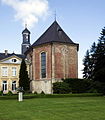Saint Gerlach
Saint Gerlach | |
|---|---|
thorn in his foot. | |
| Patronage | domestic animals |
Gerlach (Gerlache, Gerlac, Gerlachus van Houthem, Gerlac of Valkenberg) (d. c. 1170)[1] was a 12th-century Dutch hermit. His cult is centered at Houthem near Valkenburg in the south of the province of Limburg.
Life
The Vita Beati Gerlaci Eremytae, written around 1227, describes his legend and life. Originally a licentious soldier and brigand, Gerlache became a pious Christian upon the death of his wife and went on pilgrimage to Rome and Jerusalem. At Rome, he nursed the sick for seven years. He also performed rites of penance for the sins of his youth.
Upon returning to the
He was engaged in a dispute with local monks, who wanted him to enter their monastery. The common people in the area considered him a saint, but the monks appealed to the local bishop. They accused Gerlach of actually being incredibly rich, his oak actually being the location of a cache of treasure. The bishop commanded that Gerlach's oak be cut down. Gerlach, however, had by this time made powerful friends, including Hildegard of Bingen, and received protection. Nevertheless, his oak was cut down, but the bishop found no treasure and wanted to make up his mistake to Gerlach by having the oak cut up in planks and having a small hut constructed with those.
Legend states that when Gerlach had done enough penance, water from the local well transformed itself into wine three times as a sign that his sins had been forgiven. He died shortly after, barely fifty and legend has it that the last rites were administered to him by the Servatius of Tongeren himself.
The name
Gerlach is a male forename of Germanic origin, variations of which exist in many Germanic and Romance languages. Like many other early Germanic names, it is dithematic, consisting of two meaningful constituents put together. In this case, those constituents are ger (meaning 'spear') and /la:k / (meaning 'motion'). The meaning of the name is thus 'spear thrower'.
The church

Gerlach's grave became a site of pilgrimage. In 1201 a
The abbey church was rebuilt in 1721 as a new parish church for the village of Houthem. The monastery later became a hotel, the Château St. Gerlach.[5] Sint-Gerlachuskerk is a pilgrim church on the Camino de Santiago. It contains a museum and a silver reliquary housing Gerlach's skull. On the occasion of the 850th anniversary of the parish, a bust of Gerlach was reconstructed based on the skull. Contributors to the project included Charlie Watts and Ron Wood of The Rolling Stones who had a guided tour of the church and museum while staying at the Chateau during a concert in Landgraaf in June 2014.[6][7]
-
Church of Sint Gerlach, in Houthem
-
The reliquary of Saint Gerlach
-
east facade of the church
-
Houthem-Sint-Gerlachuskerk labyrinth
References
- ^ Monks of Ramsgate. "Gerlach". Book of Saints, 1921. CatholicSaints.Info. 30 January 2022
- ^ "St. Gerlachus", Archimon
- ^ Norbertine Saints and Blesseds
- ^ Sint-Gerlachus church, Houthem Sint-Gerlach
- ^ Château St. Gerlach
- ^ "Rolling Stones betalen mee aan reconstructie schedel St. Gerlach", 1Limburg
- ^ Parochie St. Gerlach te Houthem
Sources
- Saints of January 5: Gerlac
- Houthem-St. Gerlach (L): St. Gerlachus
- Bosworth-Toller Anglo-Saxon Dictionary: lác
External links
 Media related to Gerlachus van Houthem at Wikimedia Commons
Media related to Gerlachus van Houthem at Wikimedia Commons- Sanctuary of St. Gerlach




